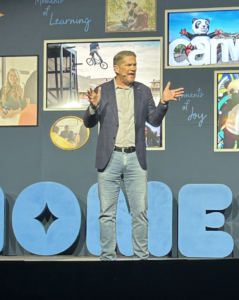After several years of disrupted learning, schools are taking stock of the range of challenges that need to be addressed—challenges resulting from the most significant disruption to K-12 education in history.
Across the nation, the pandemic has taken a toll on our children’s mental and physical health, behavioral development, social and emotional well-being, academic achievement, and plans for their future. Unfortunately, there is no quick fix. Rather, educators anticipate a multi-year process of helping struggling students recover from pandemic-related school disruptions.
Addressing the complexity and scale of these challenges requires school and district leaders to make critical choices. But they don’t need to do it alone. All those serving the education community must come together as trusted partners to find solutions, support evidence-based research, and ensure successful implementation of instructional practices to address education’s most critical challenges.
As providers serving the education market with digital learning solutions, this is our responsibility and our commitment.
- Building Teacher Capacity
One of the biggest challenges district and school leaders continue to face is how to attract and retain a stable teaching workforce. Historically, teacher shortages have been the result of both declines in the number of candidates entering the teaching profession and high rates of teacher turnover. Both have been exacerbated by the pandemic, and unfortunately, teacher turnover has a cost. It challenges student achievement and school improvement efforts.
Good instruction is good instruction, regardless of modality. Equipping teachers with effective strategies for facilitating student learning, particularly providing flexible access, ensures that educators leverage their years of experience in the classroom, along with evidence-based strategies in educational technology.
- Prioritizing Academic Acceleration and Achievement
Improving students’ academic achievement and learning outcomes is a critical priority for K-12 schools. Data from the nationally administered NAEP assessments shows declines for all student populations, and the most significant damage is among students from underserved communities.
We must employ evidence-based solutions to address the loss of instructional time and the decline in student achievement due to pandemic-related disruptions. Academic acceleration is one strategy designed to focus on teaching students grade level-appropriate lessons, while efficiently and effectively reteaching only the skills and lessons from earlier grades that are necessary to understand new content. Digital curriculum provides both the content and the data to establish personalized learning pathways for each student to accelerate learning progress and close gaps.
- Preparing Students for Their Future
Every student has the right to engage in rigorous, educational experiences that prepare them with the knowledge and skills necessary to graduate from high school with academic and career options. The workforce of the future requires that schools equip students with the right skills for the jobs of the future.
For the benefit and future of this generation, we must find solutions to workforce challenges, nurture the development of innovation and talent, and ensure the economy has the skilled workforce it needs to grow. We must take this opportunity to enable a broader and more inclusive group of learners to find success in their careers and communities. To achieve this goal, adequate and equitable investments in educational resources and supports are essential to preparing students for their future.
- Offering Hope to a Generation of Students
We must convey our belief in our students as learners, and with our help and support, encourage them to stretch beyond what they believe they can accomplish. We must give them hope for their future.
Making school a place where students are welcomed and acknowledged, where learning is focused and relevant, and where instructional approaches consider the specific needs of each student will encourage all students to reach their full potential. Building a culture focused on the success of all students is non-negotiable.
We have an opportunity to create a shared vision for education–one that will help us meet the critical challenges with which we are grappling: building teacher capacity, prioritizing academic acceleration and achievement, preparing students for their future, and offering hope to a generation of students impacted by disrupted learning.
There has never been a more critical time to explore the role access and flexibility can play in supporting student learning. A vision of high-quality blended learning is one that’s focused on the learning experiences and the people vital to them. No doubt, it will take all of us working together to achieve this goal.
Related:
46 edtech innovations at ISTELive 22
Only out-of-the-box solutions will fix the real problems in schools
- SEO Powered Content & PR Distribution. Get Amplified Today.
- Platoblockchain. Web3 Metaverse Intelligence. Knowledge Amplified. Access Here.
- Source: https://www.eschoolnews.com/2023/01/09/education-providers-path-forward/
- 1
- 2022
- a
- About
- academic
- accelerate
- access
- Achieve
- achievement
- address
- administered
- All
- alone
- among
- and
- anticipate
- approaches
- April
- author
- award
- banner
- belief
- believe
- benefit
- Beyond
- Biggest
- board
- Bringing
- broader
- Building
- candidates
- Capacity
- Career
- careers
- Center
- ceo
- challenges
- charting
- choices
- Close
- come
- commitment
- Communities
- community
- complexity
- Consider
- content
- continue
- contributors
- Cost
- create
- critical
- Culture
- Curriculum
- data
- Decline
- Declines
- description
- designed
- Development
- digital
- Director
- Disruption
- disruptions
- district
- Dont
- doubt
- each
- Earlier
- economy
- ed
- edtech
- Education
- educational
- educators
- Effective
- effectively
- efficiently
- efforts
- enable
- encourage
- engage
- ensure
- ensures
- EPI
- essential
- establish
- Ether (ETH)
- experience
- Experiences
- explore
- Face
- facilitating
- female
- Find
- Fix
- Flexibility
- flexible
- Focus
- focused
- Forward
- from
- full
- future
- generation
- Give
- goal
- good
- grade
- graduate
- Group
- Grow
- Growth
- Health
- height
- help
- helping
- High
- high-quality
- historically
- history
- honored
- hope
- How
- How To
- HTTPS
- impacted
- implementation
- improvement
- in
- Inclusive
- Influential
- Innovation
- innovations
- instructional
- Investments
- IT
- Jamie
- Jobs
- knowledge
- leader
- leaders
- Leads
- learning
- Lessons
- Leverage
- long-term
- loss
- make
- Market
- Media
- Meet
- mental
- more
- most
- multi-year
- nation
- nationally
- necessary
- Need
- needs
- New
- number
- offering
- ONE
- Opportunity
- Options
- pandemic
- particularly
- partners
- path
- People
- Personalized
- physical
- Physical health
- Place
- plans
- plato
- Plato Data Intelligence
- PlatoData
- Play
- populations
- Posts
- potential
- power
- practices
- Prepare
- preparing
- president
- prioritizing
- priority
- problems
- process
- Progress
- promise
- providers
- provides
- providing
- Quick
- range
- Rates
- reach
- real
- recognizes
- Recover
- Regardless
- relevant
- requires
- research
- Resources
- responsibility
- result
- resulting
- rigorous
- Role
- Scale
- School
- Schools
- serving
- several
- shared
- Shows
- significant
- skilled
- skills
- Social
- Solutions
- specific
- stable
- stock
- Strategic
- strategies
- Strategy
- Struggling
- Student
- Students
- success
- successful
- support
- Supporting
- Supports
- Take
- taking
- Talent
- teacher
- teachers
- Teaching
- Technology
- The
- The Future
- their
- Through
- time
- to
- together
- trusted
- turnover
- underserved
- understand
- us
- vision
- vital
- welcomed
- What
- which
- while
- will
- Women
- Workforce
- working
- world
- years
- zephyrnet













